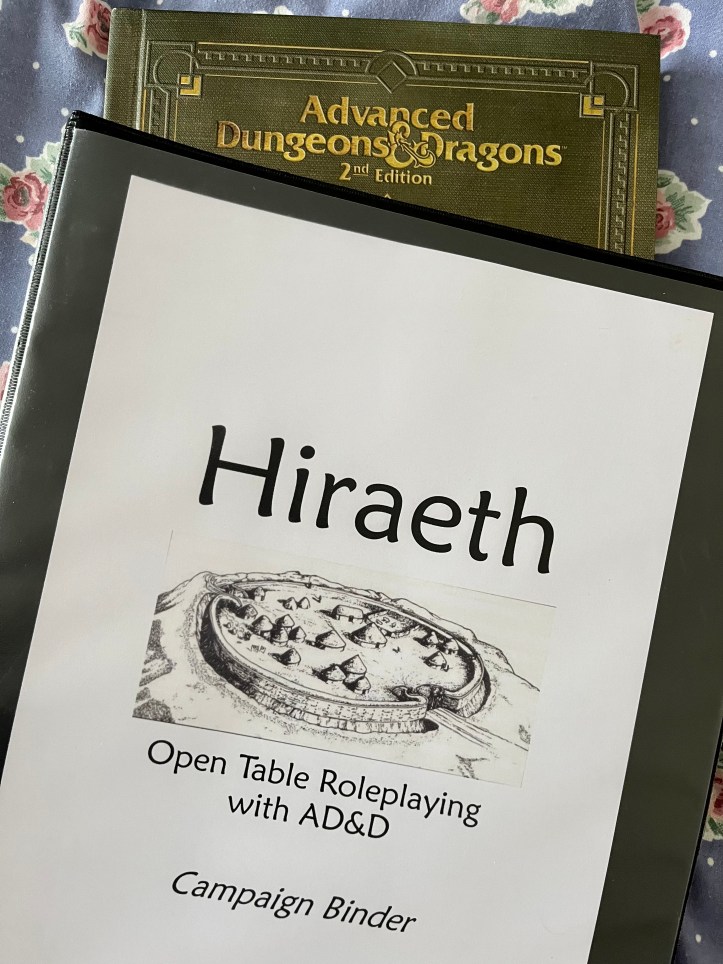Last night’s session in Hiraeth brought home a realisation that has been bubbling away for many weeks: the decision to bring all the rules behind the screen, including all the die rolls being made by the GM, has made combat scenes scarier. The reliance on description – on the physical details of the scene as rendered by the GM verbally, as opposed to reference to rules-based statistics – makes creatures seem more mysterious and the jeopardy is heightened.

A large part of the inspiration for bringing the rules behind the screen were conversations I shared with Daniel Jones about his own experiences with increasing the player’s sense of Otherworld-immersion. Additionally, I was encouraged by the discovery of Eisen’s Vow, as related within Peterson’s book, “The Elusive Shift”:
“I have decided that when I design and run my own dungeon I will not permit the players (people who do not know about D&D yet) to discover the rules.”
Sandy Eisen, as quoted by Peterson in “The Elusive Shift”
The reason for this was the experience Eisen had during the shift from his initial encounters with D&D and the later realisation that the rules broke the illusion he had previously enjoyed:
I found the first few games intensely enjoyable and exciting; I really lived the part and my ‘willing suspension of disbelief’ found myself there – in the dungeon. My actions (and of course my thoughts about these actions) were dictated by real-life considerations and no thought of wargame mechanics entered my head to distract me from the ‘events’ going on.
However, on my first games, by browsing the through the rule booklets and pestering Roger with questions, I picked up a rough idea of the game mechanics and it was this knowledge that, with the attendant realisation that D&D was just another miniatures combat system (albeit a highly imaginative and distinctive one) broke the spell of perfect involvement I had been under until then.
For those of us who first played and experienced something akin to what Eisen experienced in his first game of Dungeons & Dragons – of entering a fantastic Otherworld and inhabiting it – the quest ever since has been to find our way back to that initial depth of Otherworld-immersion.
Of course, as Eisen himself acknowledged, the decision to play with the rules hidden makes the game more challenging for the players. This is, in my experience, further heightened by the decision to bring dice rolls behind the veil too. Without the mechanisms of play to refer to directly, players must evaluate situations based on the naturalistic descriptions you give them.
As Eisen wrote:
Of course this will put them at a great disadvantage, and I feel I may have to put over quite a bit of information in the form of legend/folklore/tales so that they will have some idea of what they are up against and what to try, but all without disclosing the game mechanics. Although learning-by-your-mistakes will be a harder way, I feel that it will be more enjoyable both for the players and the referee.
Not for the first time, last night’s game revealed to me that truth of that final sentence: it is more enjoyable for many players to face the dangers of the fantastic world without reference to the rules of the game.
In a moment of combat in our game last night, the description of a large creature that, “looks like a cross between a giant green cutworm and a cephalopod” certainly got their attention. After the game, players commented on the intense concern they had felt at my description of the beast’s round maw of large teeth surrounded by eight slender, writhing tentacles. As they fought, there was palpable doubt and tension.
I’ve come to realise that the ability of the human mind to generate horror from description is powerful. I’ve read about it and even discussed it with fans of Cthulhu before but it has taken direct experience of play in this style to truly bring the insight home. Not only does the lack of mechanistic detail force the players to engage more imaginatively in the scene, the immersive effect upon them is stronger.
All in all, I keep finding that Eisen’s instincts – even if crudely expressed at the time and easily misunderstood so many years after – were broadly correct. Don’t let them know the precise details of what they are facing. Even better, don’t give them access to the mundane mechanisms of the game at all. Go for description and let their mind’s aversion to uncertainty enhance their sense of the character’s jeopardy.
Game on!
